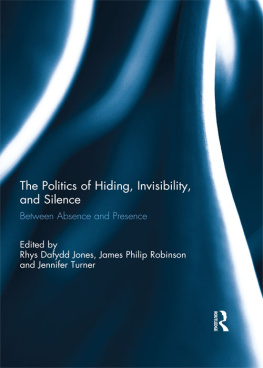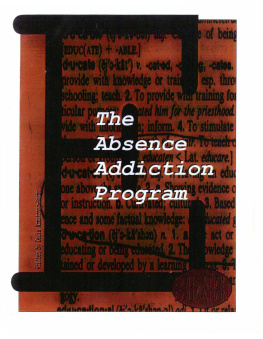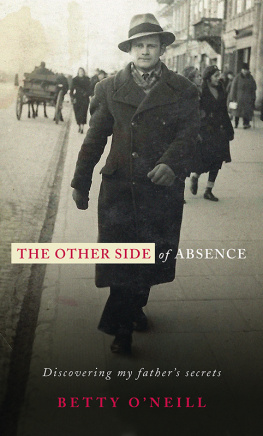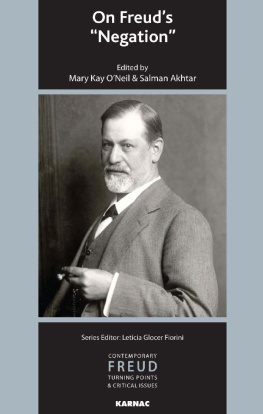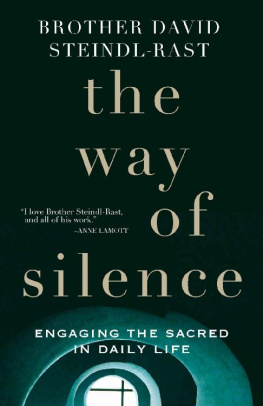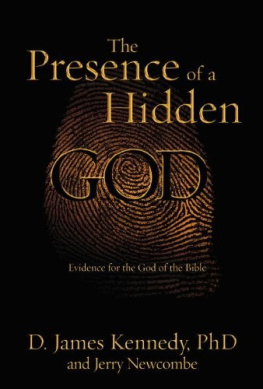The Politics of Hiding, Invisibility, and Silence
What is absence? What is presence? How are these two phenomena related? Is absence merely not being present? This book examines these and other questions relating to the role of absence and presence in everyday politics. Absence and presence are used as political tools in global events and everyday life to reinforce ideas about space, society, and belonging. The Politics of Hiding, Invisibility, and Silence contains six empirically-focussed chapters introducing case study locations and contexts from around the world. These studies examine how particular groups relationships with places and spaces are characterized by experiences that are neither wholly present nor wholly absent. Each author demonstrates the variety of ways in which absence and presence are experiencedthrough silence, forgetting, concealment, distance, and the virtualand constitutedthrough visual, aural, and technological. Such accounts also raise philosophical questions about representation and belonging: what must remain absent, and what is allowed to be present? Who decides, and how? Whose voices are heard? Recognizing the complexity of these questions, The Politics of Hiding, Invisibility, and Silence provides a significant contribution in reconciling theorizations of absence with everyday life.
This book was originally published as a special issue of Space & Polity.
Rhys Dafydd Jones, Coleg Cymraeg Cenedlaethol Lecturer at Aberystwyth University, researches the geographies of religion in rural spaces.
James Philip Robinson is a cultural-historical geographer at Queens University, Belfast, researching the geographies of camouflage.
Jennifer Turners interdisciplinary work at the University of Leicester focuses upon prison architecture and design, and its relationship to penal purpose.
The Politics of Hiding, Invisibility,
and Silence
Between Absence and Presence
Edited by
Rhys Dafydd Jones, James Philip Robinson
and Jennifer Turner
First published 2015
by Routledge
2 Park Square, Milton Park, Abingdon, Oxon, OX14 4RN, UK
and by Routledge
711 Third Avenue, New York, NY 10017, USA
Routledge is an imprint of the Taylor & Francis Group, an informa business
2015 Taylor & Francis
All rights reserved. No part of this book may be reprinted or reproduced or utilised in any form or by any electronic, mechanical, or other means, now known or hereafter invented, including photocopying and recording, or in any information storage or retrieval system, without permission in writing from the publishers.
Trademark notice: Product or corporate names may be trademarks or registered trademarks, and are used only for identification and explanation without intent to infringe.
British Library Cataloguing in Publication Data
A catalogue record for this book is available from the British Library
ISBN 13: 978-1-138-83056-1
ePub eISBN 13: 978-1-317-56890-2
Mobipocket/Kindle eISBN 13: 978-1-317-56889-6
Typeset in Palatino
by RefineCatch Limited, Bungay, Suffolk
Publishers Note
The publisher accepts responsibility for any inconsistencies that may have arisen during the conversion of this book from journal articles to book chapters, namely the possible inclusion of journal terminology.
Disclaimer
Every effort has been made to contact copyright holders for their permission to reprint material in this book. The publishers would be grateful to hear from any copyright holder who is not here acknowledged and will undertake to rectify any errors or omissions in future editions of this book.
Contents
Rhys Dafydd Jones, James Robinson and Jennifer Turner
Vincent Miller
Kirsi Pauliina Kallio
Danielle Drozdzewski
Jennifer Turner
Rhys Dafydd Jones
James Philip Robinson
A number of people have been central to this book, from its conceptualization to its publication (firstly as a special issue, and now as this volume). We are very grateful to all who inspired and supported us throughout this process. Colleagues at the Department of Geography and Earth Sciences, Aberystwyth University provided inspiration and relief in equal measure, and we are grateful to have experienced such a supportive and vibrant environment as doctoral students. We are thankful to all who contributed to the sessions organized at the 2011 AAG Annual Meeting in Seattle, both through the engaging papers that constitute this issue, and from stimulating questions that prompted their development. We are also indebted to Professor Ronan Paddison for his editorial guidance in developing the papers into a special issue for Space & Polity, to the anonymous reviewers for their helpful and insightful comments, to Stephen Thompson and Zoe Everitt at Taylor and Francis for their advice on its transformation into this volume, and to Rhona Carroll in her careful management of the project. Finally, we are grateful to our families and friends for their continued support and welcome distractions throughout this process. Diolch o galon i chi oll.
| Rhys Dafydd Jones | James Robinson | Jennifer Turner |
| Aberystwyth | Belfast | Leicester |
The chapters in this book were originally published in Space & Polity, volume 16, no. 3 (December 2012). When citing this material, please use the original page numbering for each article, as follows:
Chapter 1
Introduction. The Politics of Hiding, Invisibility, and Silence: Between Absence and Presence
Rhys Dafydd Jones, James Robinson and Jennifer Turner
Space & Polity, volume 16, no. 3 (December 2012) pp. 257264
Chapter 2
A Crisis of Presence: On-line Culture and Being in the World
Vincent Miller
Space & Polity, volume 16, no. 3 (December 2012) pp. 265285
Chapter 3
Political Presence and the Politics of Noise
Kirsi Pauliina Kallio
Space & Polity, volume 16, no. 3 (December 2012) pp. 287302
Chapter 4
Knowing (or Not) about Katy: The Silencing and Surfacing of Public Memory
Danielle Drozdzewski
Space & Polity, volume 16, no. 3 (December 2012) pp. 303319
Chapter 5
Criminals with Community Spirit: Practising Citizenship in the Hidden World of the Prison
Jennifer Turner
Space & Polity, volume 16, no. 3 (December 2012) pp. 321334
Chapter 6
Negotiating Absence and Presence: Rural Muslims and Subterranean Sacred Spaces
Rhys Dafydd Jones
Space & Polity, volume 16, no. 3 (December 2012) pp. 335350
Chapter 7
Invisible Targets, Strengthened Morale: Static Camouflage as a Weapon of the Weak
James Philip Robinson
Space & Polity, volume 16, no. 3 (December 2012) pp. 351368
Please direct any queries you may have about the citations to
clsuk.permissions@cengage.com
RHYS DAFYDD JONES, JAMES ROBINSON and JENNIFER TURNER
In both capital-P Politics, such as spectacular world events, and the little-p politics of everyday practices, absence and presence have been and continue to be particularly potent political tools, utilised to reinforce particular power relations, narratives and control over space. Absence, for example, has a long association of denying others claim to spaces, places and participation. Whether excluding particular ethnic groups from certain residential areas (Anderson, 1987), young people from shopping centres at particular times (Staeheli and Mitchell, 2008) or homeless people from urban regeneration sites (Katz, 2001), making absent has been used as a stratagem of control that removes dissenting views and experiences from particular time/places. In short, it demarcates territory where acts, people and ideas cannot belong. Similarly, the opposing part of the binary, presence, has traditionally been used to emphasise deviance. Schivelbusch (1995) has shown how, in the development of the modern metropolises of London, Paris and Berlin, artificial illumination was used as a means to give presence to misdemeanours and criminal acts which were previously concealed by shadowy and darkened spaces. For Foucault (1977), the body of the condemned served as a warning to others of the consequences of their transgressions, creating a spectacle of suffering (Spierenburg, 1984). In both these cases, fixing unwanted attention on the body was a way of installing discipline both to the perpetrator and to the gazer. Both absence and presence, in this sense, have been used as methods of social control; through a mixture of writing-out and constructing a spectacle, they denote what belongs where and when: what is in place, and what is out of place (Cresswell, 1996).

